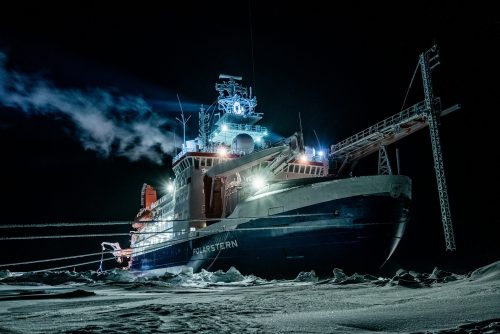Heading farther north than she has ever been
March 12, 2020
Ned Rozell
907-474-7468

On the cusp of Interior Alaska’s springtime, Melinda Webster will not experience it this year. She’ll miss most of summer, too. Webster will soon head north of Earth’s land masses, to spend the next half year cradled in ice.
Webster, a sea-ice specialist at the University of Alaska Fairbanks Geophysical Institute, will in a few days board flights that will carry her across the globe to Svalbard. From there, she will carry her bag upon a 35-passenger aircraft. She will then fly more than 500 miles northward before landing on an ice runway and riding a snowmachine to the research vessel Polarstern, an icebreaker that has been twirling in the sea ice of the Arctic Ocean since last October.
Webster came to Interior Alaska in November 2019 to take a job with the Geophysical Institute from her previous job at NASA’s Goddard Space Flight Center in Maryland. That move got her a lot closer to her specialty: sea ice, which forms on top of the ocean in very cold places. Soon, the ephemeral substance that is so influential in global weather will surround her.
Because of this, Webster will miss the 80-degree air of middle-Alaska summer after enduring a cold winter. But she doesn’t mind.
“This is really a once-in-a-generation experience,” she said.
Webster will be one of 600 researchers from 20 countries who will over the months shuttle northward to live on the Polarstern, an icebreaker owned by the Alfred Wegener Institute in Bremerhaven, Germany.

The MOSAiC expedition ship, now drifting about 100 miles from the geographic North Pole, has already hosted Fairbanks sea-ice experts Rob Rember and Marc Oggier of UAF’s International Arctic Research Center. They worked with the aid of floodlights in total darkness on the ice for seven hours each day from October through the complete darkness of the polar night of December.
Rember is headed back to the ship on the same leg as Webster, as are UAF scientists Ana Aguilar-Islas and Mette Kaufman. Oggier and UAF’s Kyle Dilliplaine will join on a later shift, which starts in a few months.
Devoted to many aspects of science, the current experiment is reminiscent of Norwegian explorer Fridjof Nansen’s journey in the late 1800s. Then, the wooden ship Fram was locked in sea ice for three years, before currents spit it out at what is now known as Fram Strait, between Greenland and Svalbard.
The Polarstern’s crew moored the ship to a large ice floe in October 2019, and the ship has been moving with it ever since. The ice outside it is the platform for a few dozen scientific experiments.
Unlike Fridjof Nansen’s journey, this expedition is shorter — only one year long — and no one will feed sled dogs to one another in a failed attempt to reach the North Pole. Also, instead of living for the entire year on the ship, people are rotating off and on board, with few spending more than a couple months straight.
Scientists expect winds and currents will carry the Polarstern out of Fram Strait, though in one-third the time it took for Nansen’s ship. That is due in part to winds having more effect on today’s sea ice cover, which has not survived as many summers and grown as thick as ice did in the 1800s.
Webster, who will return to Alaska in September, will still need the polar-bear guards that watched over Rember and Oggier, but sunglasses will be more essential than her headlamp. She heads north just as the globe is nodding toward the sun, and will experience more hours of sunlight than anyone in Alaska.
She will be collecting cores of sea ice, measuring snow depth and density, and looking for the element beryllium, which falls from space.
Webster’s measurements will help to ground-truth the data from an ice-observing satellite that sends back data she uses when back at the office. Out on the ice in her heavy clothes, she will know just when the satellite is passing, 500 miles directly over her head. She may even see its green laser beam.
She will try to determine precisely what the satellite is measuring as it transmits photons to the ice surface and times their return to the satellite. Her on-ice measurements will help make sure the satellite knows a melt pond on top of the ice from open ocean. The result will be improved estimates of sea-ice thickness using the satellite.
Webster has experienced the Arctic and its ice though trips to Utqiaġvik and other science trips on ships that plowed through the Beaufort and Chukchi seas, but she knows that living on the Polarstern will be different.
“It’s almost like living in a tiny town,” she said. “It’ll be challenging not to have privacy.”
She plans to savor her off-duty time with noise-canceling headphones that allow her to listen to audio books, and a new Kindle that helps her save weight toward the 17-pound carry-on bag she is limited to for five months of living.
Her on-duty time will be spent on the sea ice that surrounds the ship. She expects to spend at least eight hours a day on the ice, riding snowmachines to study sites. She will gather all the data she can, and may even have time to draft a few scientific papers.
In Fairbanks just before departing, Webster said she was both thrilled and nervous with the opportunity to go where few humans have scuffed their boots: on the ever-changing jigsaw pieces of ice that float on top of the world.
Since the late 1970s, the University of Alaska Fairbanks' Geophysical Institute has provided this column free in cooperation with the UAF research community. Ned Rozell is a science writer for the Geophysical Institute.


